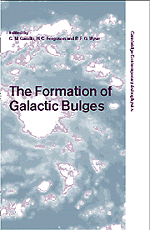Book contents
- Frontmatter
- Contents
- Preface
- Dedication: In Memory of Olin Eggen
- Part 1 Introduction
- Part 2 The Epoch of Bulge Formation
- Part 3 The Timescales of Bulge Formation
- Constraints on the Bulge Formation Timescale from Stellar Populations
- Bulge Building with Mergers and Winds
- Role of Winds, Starbursts, and Activity in Bulge Formation
- Dynamical Timescales of Bulge Formation
- Part 4 Physical Processes in Bulge Formation
- Part 5 Bulge Phenomenology
- Part 6 Conference Summary
- Index
Dynamical Timescales of Bulge Formation
from Part 3 - The Timescales of Bulge Formation
Published online by Cambridge University Press: 10 November 2010
- Frontmatter
- Contents
- Preface
- Dedication: In Memory of Olin Eggen
- Part 1 Introduction
- Part 2 The Epoch of Bulge Formation
- Part 3 The Timescales of Bulge Formation
- Constraints on the Bulge Formation Timescale from Stellar Populations
- Bulge Building with Mergers and Winds
- Role of Winds, Starbursts, and Activity in Bulge Formation
- Dynamical Timescales of Bulge Formation
- Part 4 Physical Processes in Bulge Formation
- Part 5 Bulge Phenomenology
- Part 6 Conference Summary
- Index
Summary
The relevant dynamical processes for bulge formation are reviewed: collapse, accretion, bar formation, stochastic heating and external forcing. All of these processes take place at some level, but it appears hard to escape the conclusion that bulges formed quickly and early.
Introduction
There are many beautiful examples of galaxies with prominent bulges to be found in any atlas of normal galaxies. Superficially bulges appear to share many properties with elliptical galaxies: there are many similarities in shape, stellar population and stellar dynamics between ellipticals and bulges (see Wyse, Gilmore and Franx 1997 for a review). To the eye, bulges appear to be a quite distinct component of disk galaxies. They appear as high surface brightness, concentrated central objects in the, often considerably larger and fainter, disk. Often also, they have quite a distinct colour, and, as the name suggests, they are considerably fatter than the disk.
Tempting as it is to consider bulges as a completely separate subsystem of galaxies, it would be wrong to ignore the relation between a bulge and the surrounding galaxy. Gravity links all components of a galaxy, and the central position of the bulge means that it will certainly be influenced by the other parts. Also, the bulge is the natural place for dissipated material to end up, and this is likely to have a profound effect on the star formation history of the bulge.
- Type
- Chapter
- Information
- The Formation of Galactic Bulges , pp. 83 - 94Publisher: Cambridge University PressPrint publication year: 2000



